Cessna 150
| Model 150 | |
|---|---|
 | |
| Role | Multipurpose civil aircraft |
| Manufacturer | Cessna |
| First flight | September 12, 1957 |
| Produced | 1958–1977 |
| Number built | 23,949 |
| Unit cost |
US$12,000-25,000 (2007) |
| Variants | Cessna 152 |

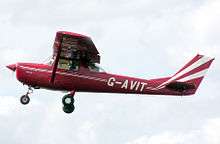
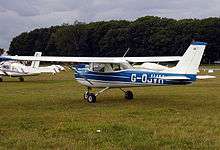
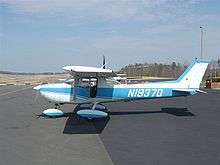
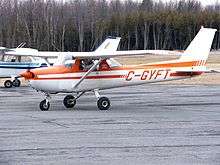
.jpg)

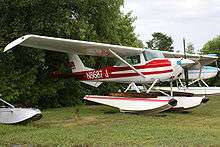
The Cessna 150 is a two-seat tricycle gear general aviation airplane that was designed for flight training, touring and personal use.[1]
The Cessna 150 is the fifth most produced civilian plane ever, with 23,839 aircraft produced.[2] The Cessna 150 was offered for sale in the 150 basic model, Commuter, Commuter II, Patroller and the aerobatic Aerobat models.
Development overview
Development of the Model 150 began in the mid-1950s with the decision by Cessna Aircraft to produce a successor to the popular Cessna 140 which finished production in 1951. The main changes in the 150 design were the use of tricycle landing gear, which is easier to learn to use than the tailwheel landing gear of the Cessna 140, and replacing the rounded wingtips and horizontal and vertical stabilizers with more modern, squared-off profiles. In addition, the narrow, hinged wing flaps of the 140 were replaced by larger, far more effective Fowler flaps.
The Cessna 150 prototype first flew on September 12, 1957, with production commencing in September 1958 at Cessna's Wichita, Kansas plant.[3] 216 aircraft were also produced by Reims Aviation under license in France. These French manufactured 150s were designated Reims F-150, the "F" indicating they were built in France.
American-made 150s were all produced with the Continental O-200-A 100 hp (75 kW) engine, but the Reims-built aircraft are powered by a Rolls Royce-built Continental O-200-As, with some Continental O-240-A powered versions.
All Cessna 150s have very effective flaps that extend 40 degrees.[4]
The best-performing airplanes in the 150 and 152 fleet are the 1962 Cessna 150B and the 1963 Cessna 150C. Thanks to their light 1,500 lb (680 kg) gross weight and more aerodynamic rear fuselage, they climb the fastest, have the highest ceilings, and require the shortest runways. They have a 109-knot (202 km/h) cruise speed, faster than any other model year of either the 150 or 152.[5]
All models from 1966 onwards have larger doors and increased baggage space. With the 1967 Model 150G the doors were bowed outwards 1.5 inches (38 mm) on each side to provide more cabin elbow room.
Production
A total of 22,138 Cessna 150s were built in the United States, including 21,404 Commuters and 734 Aerobats. Reims Aviation completed 1,764 F-150s, of which 1,428 were Commuters and 336 were Aerobats. A Reims affiliate in Argentina also assembled 47 F-150s, including 38 Commuters and 9 Aerobats.
Of all the Cessna 150-152 models, the 1966 model year was the most plentiful with 3,067 1966 Cessna 150s produced. This was the first year the aircraft featured a swept tail fin, increased baggage area and electrically operated flaps.
Design succession
The 150 was succeeded in the summer of 1977 by the closely related Cessna 152. The 152 is more economical to operate due to the increased TBO (time between overhaul) of the Lycoming O-235 engine. The 152 had its flap travel limited to 30 degrees from the 150's 40 degree deflection for better climb with full flaps and the maximum certified gross weight was increased from 1,600 lb (726 kg) on the 150 to 1670 lb (757 kg) on the 152. Production of the 152 ended in 1985 when manufacturing of all Cessna piston singles was suspended.[1]
In 2007 Cessna announced the two-seat successor to the Model 150 and 152, the Model 162 Skycatcher.
Variants
- 150
The first model year of the Cessna 150 carried no suffix letter. It was available as the "150" or the upgraded "Commuter". The engine was a 100 horsepower (75 kW) Continental O-200, the gross weight was 1,500 lb (680 kg) and flaps were actuated manually with a lever between the seats. Production commenced late in 1958 as the 1959 model year.
The cost was US$6,995 for the Standard Model 150, $7,940 for the Trainer and $8,545 for the Commuter.[3]
The 1960 model introduced a 35-ampere generator on the Commuter. The "patroller" was also introduced in 1960. This was a standard 150 with acrylic glass windows on the lower doors, 35 US gallon long-range fuel tanks and a message chute for dropping packages to the ground.
Production was 122 in 1958, 648 in 1959 and 354 in 1960.[6]
- 150A
The 1961 model incorporated enough changes to justify a suffix letter and thus was designated the “150A”.
The "A" had its main landing gear moved aft by two inches to eliminate the problem of the aircraft ending up on its tail while loading people and baggage and also to improve nosewheel steering authority.
The "A" also had 15% larger rear side windows and new adjustable seats. 344 were constructed.[6]
- 150B
The 150B was the 1962 model. It had a new propeller that increased cruise speed by 2 knots (3.7 km/h) and the option of a two-passenger child seat for the baggage compartment. 331 "B" models were built.[6] The Commuter version cost US$8,995.[7]
- 150C
The 1963 model was the "C", which introduced the option of larger 6.00×6 inch tires to replace the standard 5.00×5 tires and fuel quick drains. 472 were completed.[6]
- 150D
The 1964 "D" model brought the first dramatic change to the 150 – the introduction of a rear window under the marketing name Omni-Vision. The rear window changed the look of the 150 and cost 3 mph (4.8 km/h) in cruise speed. It also resulted in a larger baggage compartment and a greater structural weight allowance for baggage from 80 to 120 lb (54 kg). The unswept tailfin from previous years was retained for another two years. Elevator and rudder mass balances were increased to reduce flutter potential caused by the less aerodynamic rear fuselage. The gross weight of the aircraft was also increased in 1964 to 1,600 lb (730 kg), where it would stay until the advent of the Cessna 152. 804 150Ds were built.[6]
Many people find the new cabin more "airy" and pleasant, due to the increased light.[8]
- 150E
The 1965 Cessna 150E saw only the addition of new seats, although the standard empty weight went up 40 lb (18 kg) that year to 1,010 lb (460 kg). The "E" model saw production increase to 1637 aircraft.[6]
- 150F
The 1966 model saw great changes to the 150 design. The tailfin was swept back 35 degrees to match the styling of the Cessna 172 and other models. The cabin doors were made 23% wider, new brakes were brought in and the 6.00×6 tires were made standard. The previously manual flaps were now electrically actuated through a panel-mounted flap switch. The old electric stall warning system was replaced with a pneumatic-type. The baggage compartment was enlarged by 50%. A total of 3087 of the newly styled "F" models were produced.[6]
1966 was also the first production of French Reims-built F-150s, with 67 built as the F150F.[9]
- 150G
In the 1967 model, the instrument panel was redesigned. The doors were "bowed" out to give three more inches of shoulder and hip room which was needed in the small cabin. The "G" model also saw a new short-stroke nose oleo introduced to reduce the drag created by the nosewheel assembly. The previously fitted generator was replaced by a 60-ampere alternator, reflecting the increasing avionics that the planes were being fitted with.
The "G" model was also the first Cessna 150 variant certified for floats. A total of 2114 "G" models were built, plus 152 built by Reims as F150G.[6]
- 150H
The 1968 model 150 was designated the "H". It introduced a new-style center console, designed to improve legroom. A new electric flap switch was also fitted that allowed "hands-off" retraction of the flaps, but not extension. 2007 150Hs were built in Wichita, with 170 built by Reims as the F150H.[6]
- 150I
There was no 150 "India" model as Cessna didn't want it to look like a Cessna 1,501. This did not prevent Cessna from designating an "India" model Cessna 172 however.[6]
- 150J
The 150J, in 1969, brought a new key-operated starter that replaced the old "pull-style" starter. The new starter was more "car-like" but not as reliable as the old one and also more expensive to repair.
An auxiliary power plug was also made available as an option in 1969, along with "rocker" style electrical switches. 1714 "J" models were built,[6] plus 140 built by Reims as the F150J.
- 150K
1970 was the year that Cessna introduced the A150K Aerobat, a Cessna 150K with limited aerobatic capabilities. It retained the 100 horsepower (75 kW) Continental O-200 all 150s used, but differed from the baseline 150K in having more structural strength, being rated +6/-3 g. Other "aerobatic" features included four-point harnesses for both occupants, dual overhead skylights for upward visibility (which, while standard on the Cessna 140, had not been part of the 150 design) jettisonable doors, a more sporty checkerboard paint scheme and removable seat cushions so that parachutes could be worn. In 1970, an Aerobat cost $12,000 as opposed to the $11,450 price for a 150K Commuter model.[10]
Both the new Aerobat and the non-aerobatic 150K also sported new conical cambered wingtips in 1970. A total of 832 "K" models were built, including A150Ks.[6] Reims built 129 as the F150K and 81 as the FA150K.
- 150L
The 150L had the longest production run of any 150 sub-model, being produced 1971–74.
New in 1971 were tubular landing gear legs with a 16% greater width (6 feet 6 inches (1.98 m) to 7 feet 7 inches (2.31 m) for better ground handling. These replaced the previous flat steel leaf spring gear. Also in 1971, the landing and taxi lights were moved from the wing leading edge to the nose bowl to better illuminate the ground. They were an improvement, but bulb life was reduced due to the heat and vibration of that location. They were moved back to the wing on the 1984 model Cessna 152.
The "L" also introduced a longer dorsal strake that reached to the rear window. This was done more for styling than for aerodynamics and the empty weight accordingly went up 10 lb (4.5 kg) over the "K". 879 were built in 1971.
In 1972 the "L" received new fuel filler caps to reduce moisture seepage, and better seats and seat tracks. 1100 were built in 1972.
The 1973 "L" model brought in lower seats to provide more headroom for taller pilots. 1460 of the 1973 models were built.
The final "L" model was produced in 1974. The only change this model year was the propeller on the A150L Aerobat, to a new Clark Y airfoil that increased cruise by 4 mph (6.4 km/h). 1080 150s were produced in 1974.[6]
Total "L" production was 4519, plus the 485 built by Reims as the F150L and 39 FA150L Aerobats. An additional 39 were built in Argentina by DINFIA as the A-150L.[11]
- FRA150L Aerobat
Reims produced a variant of the FA150L Aerobat with a Rolls-Royce Continental O-240-A engine, 141 built.[11]
- 150M
The final Cessna 150 model was the 150M. It introduced the "Commuter II" upgrade package that included many optional avionics and trim items as standard. The "M" also brought an increased fin height, by 6 inches (150 mm). This increased the rudder and fin area by 15% to improve crosswind handling. The "M" was produced for three years: 1975–77.
Inertia-reel restraints became available as an option with the 1975 model year. 1269 1975 model 150Ms were built.
In 1976 the "M" gained a suite of electrical circuit breakers to replace the previous fuses used. It was also fitted with a fully articulated pilot seat as standard equipment (this seat had been optional on some earlier models). 1399 were built.
The 1977 model year was the last for the Cessna 150. It added only "pre-select" flaps, allowing the pilot to set the flaps to any position without the pilot having to hold the switch during flap travel, enabling the pilot to concentrate on other flying duties. Only 427 1977 model 150Ms were built as production shifted to the improved Cessna 152 in the early part of 1977.
The many refinements incorporated into the 150 over the years had cost the aircraft a lot of useful load. The very first 150 weighed 962 lb (436 kg) empty, whereas the last "M Commuter II" had an empty weight of 1,129 lb (512 kg). This increase in empty weight of 167 lb (76 kg) was offset only by a gross weight increase of 100 lb (45 kg) in 1964.[4] The 152 would bring a much-needed 70 lb (32 kg) increase in gross weight to 1,670 lb (760 kg).[6]
A total of 3097 "M" models were built during its three-year run.[6] An additional 285 were built by Reims as the F150M and 141 FA150M Aerobats. Reims also built 75 A150Ls with F150M modifications.
- FRA150M
Reims produced a variant of the Rolls-Royce Continental O-240-A powered FRA150L Aerobat with the same improvements as the F150M, 75 built.[11]
Flight characteristics
The Cessna 150 is simple, robust, and easy to fly. For these reasons it has become one of the world's most popular basic trainers.[1]
Cockpit visibility is generally good other than directly above the aircraft, where the view is blocked by the wing. This obstruction is of particular concern when, as is the case with most high-wing aircraft, the inside-turn wing blocks vision in the direction of a turn. As a partial remedy to this some 150s, including all Aerobats, feature a pair of overhead skylights.
Due to its light weight and light wing loading (10 lb/sq ft), the aircraft is sensitive to turbulence.[1][4]
Power-on and power-off stalls are easily controlled.[1] Normal spin recovery techniques are highly effective.
Modifications available
There are hundreds of modifications available for the Cessna 150. Some of the most frequently installed include:
- Vortex generators and STOL kits that reduce the stall speed of the plane.[12]
- Flap gap seals to reduce drag and increase rate of climb.[12]
- Different wing tips, some of which claim various cruise speed increases and stall speed reductions.[12]
- Auto fuel STCs, which permit the use of automobile fuel instead of the more expensive aviation fuel.
- Larger engines, up to 180 horsepower (130 kW).[12]
- Taildragger landing gear.[12]
- Auxiliary fuel tanks for larger capacity.[12]
- Door catches to replace the factory ones that often fail in service.[12]
- Belly fuel drain valves to drain fuel from the lowest point in the fuel system.[12]
Noteworthy flights
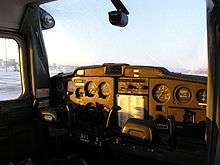
- On August 8, 1964, a pair of commercial pilots flew a Cessna 150 into the Meteor Crater in Arizona. On crossing the rim, they could not maintain level flight. The pilot attempted to build up speed by circling in the crater to climb over the rim. During the attempted climbout, the aircraft stalled, crashed, and caught fire. It is commonly reported that the plane ran out of fuel, but this is incorrect. Both occupants were severely injured but survived their ordeal.[13] A small portion of the wreckage not removed from the crash site remains visible to this day.[14]
- In the summer of 1980 a Cessna 150F was flown from London, England to Darwin, Australia in 32 stages by Janette Schönburg, a 27-year-old female pilot. Schönburg made the flight to commemorate the 50th anniversary of pioneering female aviator Amy Johnson's 1930 flight between the two cities. This aircraft, UK registration G-AWAW, was used for several years as a static display at the London Science Museum. In May 2010 it was donated to the Cessna 150-152 Club, and shipped to Florida where it is being restored by club members.[15]
- On September 12, 1994, Frank Eugene Corder intentionally crashed a Cessna 150L onto the South Lawn of the White House against the south wall of the Executive Mansion, in an apparent suicide. Corder was killed, but no one else was injured and damage to property on the ground was minimal.
- In 1996 a Cessna 150 was flown from the United States to South Africa in several stages, crossing the Atlantic along the way. An extra 60 gallon fuel tank was installed (beyond the standard 22.5 gallons) and the plane took off 500 lb (230 kg) over gross weight.[16]
Operators
Civil
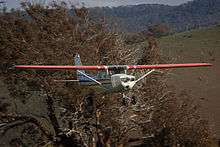
The aircraft is popular with flying schools as well as private individuals. The Embry-Riddle Aeronautical University Golden Eagles Flight Team based at Prescott, Arizona operate two 1965 Cessna 150Es. The team has won eight National Intercollegiate Flying Association National Championships since 1993.[17] Similarly, the University of North Dakota has also used Cessna 150s on the road to two of their 16 NIFA National Championships.[18]
Military

- Burundi Air Force 3 x FRA150L[19]
- Ecuadorian Air Force 24 x A150[21]
- Ivory Coast Air Force three x F150L[22]
- Liberian Army one x 150K[23]
- Mexican Naval Aviation two x 150J[24]
- Paraguayan Naval Aviation two x 150M[25]
- Somali Air Force two x FRA150L[26]
- Sri Lanka Air Force ten x 150[27]
- United States Air Force - The United States Air Force Academy Flying Team uses three Cessna 150s designated T-51A (one Model 150L, two Model 150M) for training and competition.[28] For better performance at altitude, these aircraft have been equipped with 150 horsepower (110 kW) Lycoming O-320-E2D engines and propeller combinations. These aircraft are operated by the 557th Flying Training Squadron.
Accidents
- 27 March 1968. Ozark Airlines Flight 965, a Douglas DC-9-15, collided with a Cessna 150F N8669G while landing at Lambert-St. Louis International Airport. The Cessna crashed, killing both people, but the DC-9 landed safely.[29]
- 9 January 1971. American Airlines Flight 30, a Boeing 707-323C, collided with Cessna 150 N60942 while landing at Newark International Airport. The Cessna crashed, killing both people, but the Boeing landed safely.[30][31]
- 4 August 1971. Continental Air Lines Flight 712, a Boeing 707-324C, collided with Cessna 150J N61011 while landing at Los Angeles International Airport. The Cessna crashed, injuring both people, but the Boeing landed safely.[32][33]
- 9 January 1975. Golden West Airlines Flight 261, a de Havilland Canada DHC-6 Twin Otter, collided with Cessna 150 N11421 at Whittier, California while on approach to Los Angeles International Airport, killing all 14 people on both planes.[34][35]
- 7 July 2015. Cessna 150M N3601V was involved in a mid-air collision with a General Dynamics F-16CJ Fighting Falcon over Moncks Corner, South Carolina, United States. Both occupants of the Cessna were killed; the pilot of the F-16 ejected safely. [36][37]
Specifications (1976 Commuter II)

Data from Jane's All The World's Aircraft[38]
General characteristics
- Crew: 2 (+ two children not exceeding 120 lb (54 kg))
- Length: 23 ft 11 in (7.29 m)
- Wingspan: 33 ft 2 in (10.11 m)
- Height: 8 ft 6 in (2.59 m)
- Wing area: 160 sq ft (15 m2)
- Empty weight: 1,122 lb (509 kg)
- Max takeoff weight: 1,600 lb (726 kg)
- Powerplant: 1 × Continental O-200-A air-cooled horizontally-opposed engine, 100 hp (75 kW)
Performance
- Maximum speed: 109 kn (125 mph; 202 km/h) at sea level
- Cruise speed: 82 kn (94 mph; 152 km/h) at 10,000 ft (3,000 m) (econ cruise)
- Stall speed: 42 kn (48 mph; 78 km/h) (flaps down, power off)
- Never exceed speed: 140 kn (161 mph; 259 km/h)
- Range: 420 nmi (483 mi; 778 km) (econ cruise, standard fuel)
- Service ceiling: 14,000 ft (4,300 m)
- Rate of climb: 670 ft/min (3.4 m/s)
- Take-off run to 50 ft (15 m): 1,385 ft (422 m)
- Landing run from 50 ft (15 m): 1,075 ft (328 m)
See also
- Related development
- Aircraft of comparable role, configuration and era
- Alpha 2000 (Robin R2000)
- Beechcraft Skipper
- Diamond DA20
- Grumman American AA-1
- Liberty XL2
- Piper Tomahawk
- Symphony SA-160
- Related lists
References
Notes
- 1 2 3 4 5 Plane and Pilot: 1978 Aircraft Directory, pages 22-23. Werner & Werner Corp, Santa Monica CA, 1977. ISBN 0-918312-00-0
- ↑ Thompson, William (1991). Cessna Wings for the World. Bend, Or.: Maverick Publications. p. 16. ISBN 0-89288-221-2.
- 1 2 Thompson, William (1991). Cessna Wings for the World. Bend, Or.: Maverick Publications. p. 9. ISBN 0-89288-221-2.
- 1 2 3 National Flightshops: All Those Cessna 150s. National Flightshops, St Petersburg FL, 1978.
- ↑ "Flight Training - File Not found". aopa.org. Retrieved 8 July 2015.
- 1 2 3 4 5 6 7 8 9 10 11 12 13 14 15 Clarke, Bill: Cessna 150 and 152 first edition, pages 26-95. TAB Books, 1987. ISBN 0-8306-9022-0
- ↑ Thompson, William (1991). Cessna Wings for the World. Bend, Or.: Maverick Publications. ISBN 0-89288-221-2.
- ↑ Thompson, William (1991). Cessna Wings for the World. Bend, Or.: Maverick Publications. p. 11. ISBN 0-89288-221-2.
- ↑ Thompson, William (1991). Cessna Wings for the World. Bend, Or.: Maverick Publications. p. 12. ISBN 0-89288-221-2.
- ↑ Thompson, William (1991). Cessna Wings for the World. Bend, Or.: Maverick Publications. p. 14. ISBN 0-89288-221-2.
- 1 2 3 Simpson 1996, pp.96-97
- 1 2 3 4 5 6 7 8 Clarke, Bill: Cessna 150 and 152 first edition, pages 197-212. TAB Books, 1987. ISBN 0-8306-9022-0
- ↑ Harro Ranter. "ASN Aircraft accident 08-AUG-1964 Cessna 150 N6050T". aviation-safety.net. Retrieved 8 July 2015.
- ↑ Tobin, Jim (2003). "The Last Crash". Retrieved 2007-10-25. Includes photos of the remaining wreckage, taken from several thousand metres away.
- ↑ Administrator. "G-AWAW Why is it Important?". g-awaw.org. Retrieved 8 July 2015.
- ↑ "Transatlantic Cessna".
- ↑ Embry-Riddle Aeronautical University (May 2007). "PRESCOTT'S GOLDEN EAGLES ARE THE NATIONAL CHAMPIONS OF 2007!". Retrieved 2009-10-20.
- ↑ University of North Dakota (May 2010). "UND Flying Team captures 16th national victory.". Retrieved 2012-04-03.
- ↑ Andrade 1982, Page 36
- ↑ Andrade 1982, Page 342
- ↑ Andrade 1982, Page 57
- ↑ Andrade 1982, Page 126
- ↑ Andrade 1982, Page 147
- ↑ Andrade 1982, Page 157
- ↑ Andrade 1982, Page 176
- ↑ Andrade 1982, Page 194
- ↑ Andrade 1982, Page 209
- ↑ "DOD 4120.15-L - Addendum". designation-systems.net. Retrieved 8 July 2015.
- ↑ NTSB Report Archived October 4, 2012, at the Wayback Machine.
- ↑ NTSB Report
- ↑ NTSB Report
- ↑ NTSB Report
- ↑ NTSB Report
- ↑ NTSB Report
- ↑ NTSB Report
- ↑ "Two dead after F-16, Cessna collide over South Carolina". Fox News. Retrieved 8 July 2015.
- ↑ "Two Dead In F-16-Cessna Collision". AVweb. Retrieved 8 July 2015.
- ↑ Taylor 1976, p. 254.
Bibliography
- Cessna 150 Type Certificate number 3A19, Federal Aviation Administration
- U.S. Air Force Academy, Public Affairs. "Biography". Fact Sheet: Airmanship. Archived from the original on 2006-06-15. Retrieved 2006-10-01.
- Andrade, John. Militair 1982, Aviation Press Limited, London, 1982, ISBN 0-907898-01-7
- Simpson, R.W. Airlife's General Aviation, Airlife Publishing, England, 1991, ISBN 978-1-85310-194-6
- Taylor, John W. R. Jane's All The World's Aircraft 1976–77. London: Jane's Yearbooks, 1976. ISBN 0-354-00538-3.
External links
| Wikimedia Commons has media related to Cessna 150. |
- Airliners.net - Aircraft Data - Cessna 150 & 152
- Cessna 152 Aerobat Smithsonian National Air and Space Museum website
- 150/152 Model History